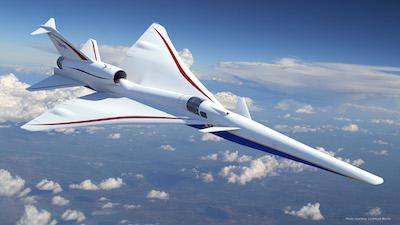Mon, Jan 21, 2019
Collins And Lockheed Martin To Jointly Develop Tailored Pro Line Fusion Avionics
In line with its vision to redefine aerospace, Collins Aerospace has been selected by Lockheed Martin to provide avionics for the new X-59 Quiet Supersonic Technology (QueSST) aircraft. The X-59 is being developed by Lockheed Martin for NASA to collect data that could make supersonic commercial travel over land possible through low sonic boom technology.

Collins will provide developmental engineering support to tailor its Pro Line Fusion avionics to the specific requirements of the X-59. By jointly developing software applications side-by-side, Lockheed Martin will receive an optimized solution which will also include Collins' award-winning touchscreen primary flight displays with tailored multi-function windows, head-up display (HUD) symbology, synthetic vision, ARC-210 communication radios, and a suite of navigation and surveillance equipment. Lockheed Martin will house a System Integration Lab for the Pro Line Fusion avionics at its facility in Palmdale, California.
In addition, Collins will provide a dual multi-spectral enhanced vision system (EVS-3600). In order to achieve supersonic speeds with a low sonic boom signature, the X-59 must have a long and slender shape. This shape also makes a forward-looking window impractical. The EVS-3600 will enable pilots to land in nearly all conditions using advanced visual sensors leveraging long wave, infrared technology.
"Our industry-leading avionics, combined with one of the most advanced EVS cameras in the market, will add to the safety and efficiency of this forward-leaning aircraft," said Dave Schreck, vice president and general manager for Military Avionics and Helicopters at Collins Aerospace. "We look forward to working with Lockheed Martin and NASA to play an integral role in making quiet supersonic travel over land possible for passengers."
The X-59, which is expected to take its first flight in 2021, is designed to create a sound about as loud as a car door closing, instead of a sonic boom. It will be used to collect data on the acceptability of the quiet sonic boom generated by the aircraft, helping NASA establish an acceptable commercial supersonic noise standard to overturn current regulations banning supersonic travel over land.
(Image provided with Rockwell Collins news release)
More News
Option Approach An approach requested and conducted by a pilot which will result in either a touch-and-go, missed approach, low approach, stop-and-go, or full stop landing. Pilots >[...]
"Emirates is already the world's largest Boeing 777 operator, and we are expanding our commitment to the program today with additional orders for 65 Boeing 777-9s. This is a long-t>[...]
(Pilot) Reported That There Was A Sudden And Violent Vibration Throughout The Airplane That Lasted Several Seconds Analysis: The pilot was returning to his home airport at an altit>[...]
“This recognition was evident during the TBMOPA Annual Convention, where owners and operators clearly expressed their satisfaction with our focus on customer service, and enc>[...]
Overhead Maneuver A series of predetermined maneuvers prescribed for aircraft (often in formation) for entry into the visual flight rules (VFR) traffic pattern and to proceed to a >[...]
 ANN's Daily Aero-Term (11.19.25): Option Approach
ANN's Daily Aero-Term (11.19.25): Option Approach Aero-News: Quote of the Day (11.19.25)
Aero-News: Quote of the Day (11.19.25) NTSB Final Report: Sting Sport TL-2000
NTSB Final Report: Sting Sport TL-2000 Aero-News: Quote of the Day (11.20.25)
Aero-News: Quote of the Day (11.20.25) ANN's Daily Aero-Term (11.20.25): Overhead Maneuver
ANN's Daily Aero-Term (11.20.25): Overhead Maneuver



